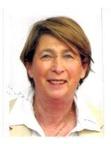Dorothea Shefer-Vanson's Blog, page 8
March 8, 2024
Walter Benjamin’s ‘Little History of Photography’
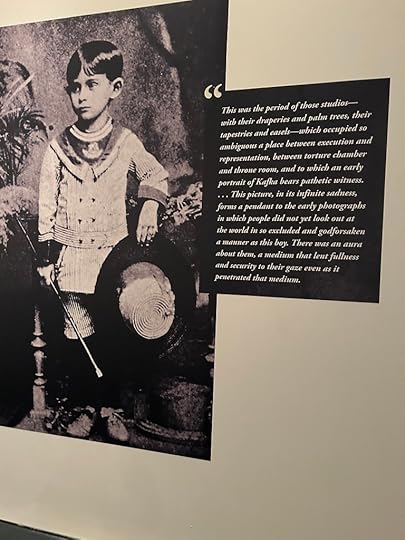
The exhibition now being shown at the Israel Museum brings together works by the photographers mentioned in Walter Benjamin’s seminal essay about photography which was published in three parts in a German literary journal in 1931. The exhibition echoes the title given by Benjamin to his study of photography, which was still in its early stages, constituting a synthesis between art and technology that inspired a new approach to the world of ideas.
The curator of the exhibition, Gilad Reich, notes that the Israel Museum has in its collections images produced by all the photographers mentioned in Benjamin’s study, this being a rare and singular feature not shared by many museums in the world. Benjamin was one of the first art and culture critics to view photography as a way of relating to the world through images captured by means of a technology that was relatively new, imparting to the image a meaning that was new and possibly even revolutionary. Benjamin coined the concept of ‘aura’ as defining the image and its effect on the viewer.
As we move through the exhibition and view the images on display we find ourselves moving through the history of the photographic medium. It developed initially when Louis Daguerre invented a complex process for reproducing images in 1839, while later technological advances enabled images to be more easily reproduced. Thus, in Victorian England the concept of the ‘photographic visiting card’ bearing a picture of the individual was adopted by Queen Victoria and became widely popular. Photographic studios became the focus of the desire to commemorate the individual or family as an image that was more readily available to a wide segment of the population.
Benjamin, however, was critical of such commercial photographic studios, noting with derision their paraphernalia and ‘props’ intended to enhance the impact of the image or portrait. In the exhibition an enlarged photo of young Franz Kafka illustrates this concept, with the serious young boy holding a stick and a large black hat, surrounded by heavy, dark furniture emphasizing the gravity of the situation.
The technology of photography was still clumsy and demanding when Benjamin was writing about it, with the need for metal plates, chemical processes for developing the image in a dark room, and cumbersome camera equipment. With the passage of time, the emergence of the box camera, special photographic paper, and – more recently – the mobile phone have helped to make the process of photography easy and accessible to all.
Thus, while Benjamin’s concept of ‘aura’ may have lost something of its significance, in its place has come immediacy and the ability to capture the fleeting, ephemeral image which might have interested and intrigued him just as much, had he not died tragically in 1940 while seeking to escape the Nazis on the border between France and Spain.
February 29, 2024
Errata; an Examined Life: A Life in Ideas
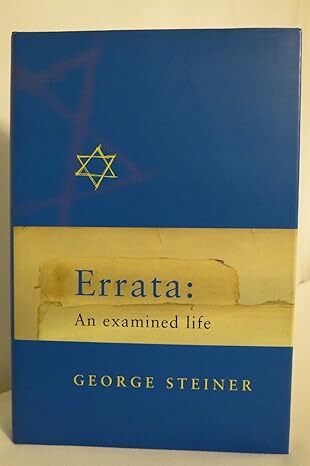
The name of George Steiner arouses reverence in the minds of anyone conscious of the role played by language in the world of culture, literature and ideas. Steiner’s seminal books, ‘After Babel’ and ‘Language and Silence,’ occupy pride of place on my bookshelf and that of anyone concerned with translation and the history of ideas. So it was with bated breath that I embarked on reading one of Steiner’s last books, a kind of summing-up of his life and work. A telling sign – the only image on the rather plain cover of the book is a small Star of David, the symbol of the Jew.
The book starts out as if it were a memoire, describing the tedium of childhood holidays spent in the verdant Austrian countryside where the constant downpour kept the young George inside the house. Relief came in the form of a book of heraldry bought by an uncle, which fascinated the child and led him to an instinctive awareness of individuation rather than theory.
Born in 1929, George Steiner’s early childhood was spent in Paris in a family where French, German and English were all spoken. Faced with the threat of invasion by Nazi Germany, his father, a successful economist who taught his son Greek and Latin, took the family to the USA, where George was enrolled in the French Lycée in Manhattan. While there, alongside the children of diplomats and other Jewish emigrés, he was iintroduced to the work of Shakespeare and the English and American poets, while acknowledging the supremacy of modern French literature. His polyglot upbringing led him to an awareness of language and literature as cultural agents (and his cognizance of the work of the translator as ‘honest treason’).
Steiner, who died in 2020 and has been described as a ‘polyglot and polymath,’ gives an entertaining account of his time in the late 1940s at the University of Chicago, sharing a room with an ex-paratrooper who stunned the young George with his physical prowess and arranged for his sexual initiation (by a kindly prostitute), requiring solely some tutoring in academic subjects in return. It was not long before young George found himself tutoring groups of students, and thus found his calling as a teacher, enabling others to understand texts that they found impenetrable.
Devoting an entire chapter to the State of Israel, Steiner describes the attendance of prominent international figures at the funeral of assassinated Prime Minister Yitzhak Rabin and then ruminates on the ‘anomaly of Jewish survival’ as so many great ancient civilisations have disappeared. Defining modern Israel as an ‘indispensable miracle,’ he tries to explain Jewish survival as a combination of ethical values, adherence to traditional practices, and strong family bonds. Steiner notes that Jews continue to persist despite millennia of persecution and pogroms which culminated in the Shoah, and that Jews in Israel still adhere to their ancient language, produce exceptional scholars and scientists and are no longer ‘unwelcome guests’ in other countries.
Music has played an important part in Steiner’s life, providing both solace and an area of study. He asserts that talking about music sets the boundaries of language, and he regards it as a meta-language, affecting human consciousness (as exemplified in the writings of Proust, Mann, Joyce, for example) and, evidently speaking from experience, regarding it as something without which life on earth would probably be unbearable for many. Steiner also extolls the virtues of growing up in a bi-lingual or multi-lingual environment, as he did, and castigates those who insist that monolingualism is better for a child, serving to open additional ‘windows on the world.’ Contemporary culture is based on translation, he claims, citing the instances of the Bible and Roman Law. He does not regard machine translation as a threat to the human translator except in the case of routine and technical texts.
Steiner regards the twentieth century as ‘the most bestial in recorded history’ even though death and destruction have always been prevalent throughout human existence. The greatest scientific advances have been made in that century, with the widespread improvement in social conditions, medicine and communications. He mentions teachers who have made an impression on him from his schooldays to his time at various universities throughout the world, and also credits certain students with having stimulated his thinking on various subjects. He writes with affection about places he has visited, bookshops he has frequented and with regret about mistakes he has made (due to pressure of time or deadlines). He is sorry that he did not continue to draw or paint, did not learn Hebrew and did not try LSD.
Altogether, reading this book is an exciting and stimulating journey into the mind and life of one of the leading thinkers of our time, and almost as soon as I had finished reading it I resolved to read it once again, as there are so many profound and interesting insights into the world of ideas that it is impossible to absorb everything at the first reading.
February 22, 2024
Israel’s New National Library
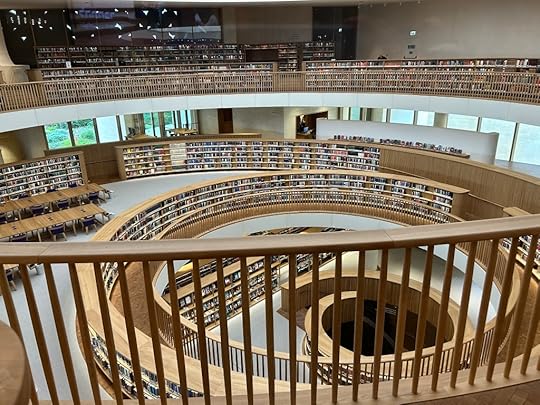
When I was a graduate student at the Hebrew University’s Givat Ram campus many years ago, before the Six Day War and the University’s return to its original campus on Mount Scopus, the National Library building served as a haven and focal point where one could sit and study in an atmosphere of silence and detachment from the world outside. The fact that it was located on the university campus meant that it was easily accessible for all students. The changing exhibits provided additional interest, and the enormous, colourful stained-glass windows by Mordechai Ardon helped to create the library’s unique atmosphere. Those windows remain in their place as they could not be safely moved to the new building.
The new National Library building is no longer part of the Hebrew University’s Givat Ram campus, being situated about half a kilometre away from it, opposite the Knesset, in close proximity to government buildings, the Israel Museum and other museums It constitutes an integral part of the concept formulated by Israel’s founding fathers of physically uniting Israel[‘s spiritual and practical heritage with its governing body in the entire hill area overlooking Jerusalem known as Givat Ram. The building itself provides an impressive yet welcoming space for anyone seeking to use its facilities, whether to study, view any of its exhibits, engage in research activity or meet with other scholars.
Several art works adorn the library’s walls and spaces, both inside and outside the building, serviing to underline the Jewish people’s connections with the Bible and other writings, as well as echoing aspects of the Land of Israel. The library also contains collections of books, manuscripts and other documents bequeathed or donated by Jewish and Israeli intellectuals, as well as unique collections such as Albert Einstein’s letters, Isaac Newton’s contemplation of the Bible, and the unique Gershom Shocken Collecetion of Kabbalah and Hasidism. When I visited the Library a few weeks ago the first thing that caught my eye was a huge, colourful wall containing hundreds of portraits and dedicated to the memory of all those killed by Hamas in the 7th October massacre and the soldiers who have fallen in the current war in Gaza.
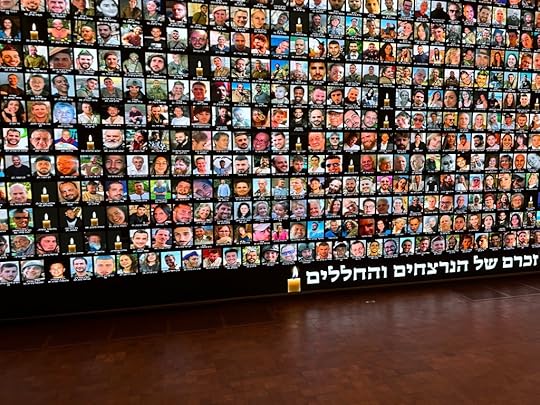
The new building has been designed with the intention of fulfilling the needs of readers and users while meeting green construction principles and maintaining energy sustainability. The stone block of the building is topped by a concave roof with a large circular skylight enabling natural light to enter the central reading room without inflicting undue damage on the books inside. Crevices in the external walls serve as windows, also allowing light to enter in a way that is neither obtrusive nor harmful to the books inside.
Originally founded in 1892, the Library now holds over five million books, periodicals, special collections, rare manusctiprs, personal and institutional archives, newspapers, maps and photographs as well as the National Music Archives comprising records, compact discs, audio recordings and digital files. Through its collections the National Library represents Israeli society in all its diversity.
February 15, 2024
Verdi’s Requiem Revisited
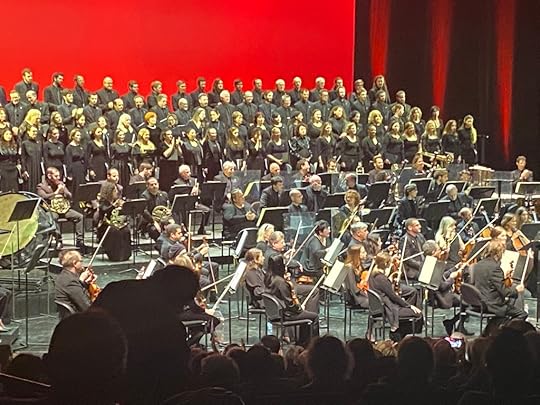
A performance of Verdi’s Requiem is not your run-of-the-mill concert, as it requires a large orchestra and choir, as well as special instruments and an unusual disposition of their location and performance. Thus, for example, the timpani have a prominent role to play in emphasizing the drama of the music and the words, the effect of the trumpets is amplified by having them placed on either side of the balcony above the orchestra in the Tuba Mirum (Trumpets shall sound) segment, not to mention the enormous, heart-stopping impact of the massed choir and orchestra singing ‘Dies Irae,’ (Judgement Day).
The requiem mass is essentially a prayer for the dead sung in Latin, as is customary in the Christian religion, even though many of the words and sentiments draw on the traditional Jewish liturgy. This is the case in the passage ‘Liber Scriptus Proferetur,’ (The Book is Open) which is a clear reference to the book supposedly kept by the deity in the Yom Kippur service, where the fate of each individual for the coming year is decided. The same can be said of the Sanctus (Holy) segment, which echoes the ‘Kadosh, Kadosh,’ in the Jewish Sabbath liturgy, extolling the sanctity of God. In fact, the Hebrew prayer for the dead starts by proclaiming the sanctity of God and is known as ‘Kadish.’
At the performance we attended last week at the Tel Aviv Opera, conducted by Dan Oettinger, the choir and orchestra filled the stage usually devoted to the singers involved in the operatic performance when the orchestra and the conductor are tucked away out of sight in the orchestra pit. However, as is customary when an opera is being sung, usually in Italian, the translation into Hebrew and English appears in surtitles above the stage, enabling the audience to follow the plot. Of course, there’s no plot in a requiem, but it helps to be able to know the meaning of what is being sung.
My late father was very fond of Verdi’s Requiem, and the LP records of a stellar performance of the work were a treasured item in our home in London. My father liked to listen to music and work at his desk on Sunday mornings (as orthodox Jews, we did not work or employ electrical appliances on Saturday, the Sabbath), and it was often my task to remain besides the gramophone and turn or change the records so that Dad (and we) could enjoy the music.
At one stage I came across a small book on my parents’ bookshelf entitled ‘Requiem in Theresienstadt,’ by Josef Bor. It described the enormous effort made by musicians and inmates at the concentration camp, led by Rafael Schaechter, to prepare and perform Verdi’s Requiem despite the unbearable conditions under which they were forced to live. Using a smuggled score, they performed the Requiem sixteen times, including one performance before senior SS officials and an International Red Cross delegation. The conductor Rafael Schaechter reportedly told the choir “We will sing to the Nazis what we cannot say to them.” My paternal grandmother was incarcerated in Theresienstadt and perished there, so my family has a special connection to the performance of the Requiem there. Today an association known as ‘Defiant Requiem,’ dedicated to the memory and reproduction of that performance, continues to commemorate the event.
At the performance in Tel Aviv last week the audience sat in rapt silence as the orchestra played and the choir and soloists sang, bringing the majesty and drama of Verdi’s music to life. In Israel of today, with war being waged in the Gaza Strip and skirmishes raging in the north of the country, the performance of the requiem has special significance. In the plaza of the nearby Tel Aviv Museum families of the hostages held in Gaza were demonstrating in order to convince the government to do more to get them released.
In a very moving moment as the Requiem ends, the soprano lowers her voice and pleads with God in what is almost a whisper to save her from eternal death in hell, with the words ‘Libera Me’ (Release me). But in an action that sent shivers down the spine of everyone in the audience that night, the translation above her head read: ‘Release them,’ in an obvious reference to the current situation in Israel.
February 8, 2024
Our Neighbours
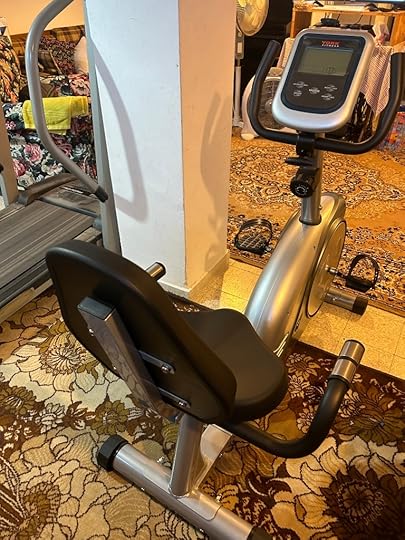
We bought an exercise bike via the internet. We chose the option to have it assembled rather than doing the work ourselves. My OH is very technically savvy and loves tinkering with machinery and equipment, but the prospect of being responsible for assembling complex exercise apparatus was daunting. And besides, even at the age of 83 he’s a busy person, and preferred to let someone else undertake that onerous duty.
On the appointed day a van drew up outside our house, and from it emerged three young men, all wearing black T-shirts and black trousers. They maneuvered the rather large carton containing the equipment into our house and down the stairs to our basement. Once there, they promptly unpacked the contents and sat down on the floor around it, inserting screws and bolts in their places, turning wheels to and fro and getting the bike assembled. As they talked and laughed among themselves we realized that they were speaking in Arabic. After they left it dawned on us that, like the Hamas terrorists, they could have overpowered and killed us.
The following week we had the air-conditioning units with which we heat and cool the various rooms of our house checked. We have had them for a long time and it is advisable to make sure that they are working well with regard to energy efficiency and effective operation. The two young men who came to do the work arrived with a box of tools and a small ladder enabling them to gain access to the units, which are installed high up on a wall of each room. They, too, were Arabs, as we ascertained when they spoke to one another. They worked in all the rooms of the house and went away, having done a good job.
The person who delivered and installed our new drier (we’d had our previous one for almost fifty years) was an Arab. The people who work in many of our local stores are Arabs. All of them provide polite, honest and efficient service.
When I need to collect my prescription medicines for the local medical clinic I am almost invariably attended to by one of the Arab pharmacists, both male and female, who work there. The same applies to many of the nurses and even some of the doctors who provide my various medical needs in this and other clinics. Not to mention the many physicians and surgeons in our hospitals.
At the moment, as a result of the war and the Hamas massacre of 7th October, Arab residents of the West Bank are not allowed to enter Israel. The builder on whom we rely for the various repair and construction jobs that we have implemented over the years told us over the phone that he cannot enter Israel just now. So our building work will have to wait until that situation is remedied.
The restaurants and shops in the neighbouring village of Abu Ghosh are suffering from the lack of customers as Israelis have reduced their visits there in the last three months. Whenever my OH and I go to eat in one of them we are greeted like old friends and given delicious food and excellent service.
All of the Arabs who provide the services I have mentioned live in nearby villages which are within Israel proper. They come into our homes, deal with the matter they have been trained to provide, clear up the debris and return to their homes. They do not kill us or harm us. At a time when Israel is at war with Hamas in Gaza, many Israeli Arabs (mainly Druze) are an integral part of the IDF and are fighting side-by-side with Jewish soldiers. Although terrorists have used vehicles to harm the general population, such incidents are relatively rare. After all, similar attacks could in theory happen at any time anywhere in Israel.
It is my firm belief that most Arabs wish to live in peace with us, their neighbours, earning a living, making a home, and creating a life that provides security and prosperity for their families. The exceptions who use our good will to our – and their – detriment will not prevail, and in the long run logic — and peace — will prevail.
February 1, 2024
Possession; a Romance
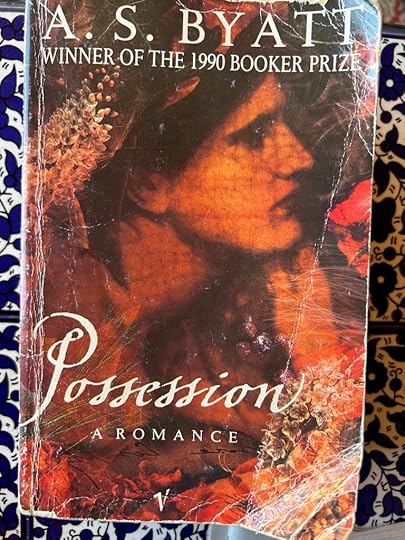
Reading this terribly clever book by A.S.Byatt aroused a gamut of emotions in me. I found it challenging, entertaining, irritating, moving and finally even exciting. It is a novel about writers (poets) and literary research, switching its time-frame between the nineteenth and twentieth centuries, focusing on contemporary literary criticism and the poetic idiom of the nineteenth century. It purports to represent the ideas and writing of two nineteenth century poets who became involved with one another’s lives, with all kinds of unforeseen and unexpected consequences.
The book is a veritable tour-de-force, presenting the supposed writings of the various characters in the form of their poetry, journals and correspondence, all tied together through the medium of the account from the viewpoint of the omniscient narrator. Several plpot lines connect and intertwine throughout the book, and the reader has to be alert to the constant switches in time-frame and point of view.
It’s all very admirable, well-written and original, but the irritating aspect is the resort to long passages delivered in italics or a smaller than customary font in order to indicate departure from the overriding narrative. This makes for difficult reading. In addition, anyone not intrinsically interested in nineteenth-century English poetry (e.g., this reader) can find themselves annoyed by having to plough through interminable verses of obscure poetry, no matter how clever. I found myself skipping most of those passages or even chapters. After all, who has the patience to work their way through all that versification together with emotional stanzas combined with literary and classical references?
As well as a sort of backhanded love story between the main contemporary characters, the literary researchers, it is also an account of an illicit affair between the nineteenth century poets. In addition, especially towards the end, it is also a detective story as rival literature departments of English and American universities strive to gain access to and control of the documents that reveal the underpinnings of the complex and complicated emotional couplings, complete with a surprise ending.
In the context of today’s events in Israel it is entertaining to come across a reference to Gaza, in the principal poetic character’s description of his disruption of a séance. This is presumably referring to Samson’s destruction and suicide, and mention is made of Milton’s ‘Samson Agonistes.’
The book makes for interesting albeit challenging reading, and was awarded the prestigious Booker Prize in 1990. It presents a literary feast for the cognoscenti, but is not the kind of easy reading to take on holiday.
January 23, 2024
The Emperor of Atlantis
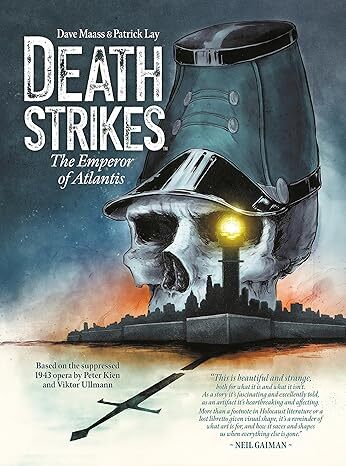
My connection with the Theresienstadt concentration camp, or ghetto, is based on the fact that the grandmother I never knew, Regina van Son, was deported there from her home-city of Hamburg in 1942, and perished there a few months later.
I have maintained my late father’s subscription to the Theresienstadt memorial museum in Kibbutz Givat Chaim Ihud, though have not visited the place for several years. My interest has focused primarily on the artistic and musical activities that were held in the camp under Nazi rule, and these were many and varied, many of them truly amazing. The prisoners, many of whom were acknowledged scholars and artists in a wide range of fields, managed to maintain a rich and diverse artistic and intellectual life there. Musical performances were held despite the difficult conditions, enabling the starving detainees to benefit from some kind of spiritual succour. Thus, performances of Mozart and Verdi operas were organized as well as lectures, chamber music concerts and recitals by individual artists. The performance of Verdi’s Requiem that was given there, despite the adverse circumstances, has gone down in history and even given rise to a contemporary organization which has revived and restored that stirring event. Over the years I have attended concerts at which music composed by prisoners at the camp have been played. These have always been emotionally moving for both performers and audience.
One of the composers incarcerated at the camp was Victor Ullmann, a rising star among Czech musicians, who had studied with Arnold Schoenberg and won several prizes for his compositions. Together with Peter Kien, who wrote the libretto, Ullmann composed the music for an opera entitled ‘The Emperor of Atlantis,’ an allegory of the Nazi regime, in which Death goes on strike in protest at the widespread killing of human beings by a power-mad ruler. The opera was performed in the Theresienstadt camp, but has rarely been performed since, though knowledge of its existence was widespread.
So imagine my surprise when I opened my morning newspaper a few days ago to find an extensive article about a graphic novel that has recently been published based on the text of the opera and original sketches used to illustrate it. The title of the book is ‘Death Strikes; the Emperor of Atlantis,’ which I feel is slightly misleading, as the meaning is unclear, or perhaps ambiguous. That may be deliberate, but I feel that a better title would be ‘Death Goes on Strike; the Emperor of Atlantis.’
Be that as it may, the point is that the American author of the book, Dave Maass, together with illustrator Patrick Lay, has managed to create a new work based on the original opera by Victor Ullmann and Peter Kien, providing a new kind of memorial for the artists of the camp who, as in the cases of Ullmann and Kien and so many others, were later deported to Auschwitz and murdered there.
The fact that works of artistic importance could be created in the conditions of a concentration camp provides a beacon of hope and consolation in dark times, revealing the strength of the human spirit and even, perhaps, the eternal resilience of the Jewish soul.
January 14, 2024
Israel at War
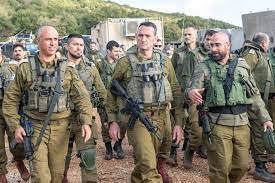
When Israel was invaded by Hamas terrorists on October 7 2023 the effect of the attack was two-fold. The horror at the brutality inflicted on men, women and children and the physical devastation of homes and entire communities, the event evoked memories of previous assaults on Jews throughout our long history of victimhood.
Apart from horror at the human suffering inflicted on unsuspecting civilians there was anguished astonishment at the failure of Israel’s defense systems and military forces to prevent this devastation. After all, Israel was established in order to enable the Jewish people to defend itself and not find itself vulnerable and open to attack by its enemies, as was the case throughout history.
And so, once again, we find ourselves at war, fighting for our lives, scrambling to defend our borders, protect our towns and villages, move large segments of our population to safety, out of the range of marauding gangs and, preferably out of the range of rockets (though to tell the truth, nowhere in Israel is out of the range of rockets from one hate-consumed enemy or another).
Who are these hate-consumed enemies? Are they all Arabs everywhere? All Moslems? There are billions of them, and no force in the world could stop them overrunning Israel if they put their minds to it, by concerted action. Of course, we all know that not all Arabs, not even all Moslems are dedicated to the destruction of Israel and Jews, signed agreements with several Arab countries contradict this, but the major entity behind all the current antagonism is Iran, which encourages, finances and fosters hatred of Israel wherever it can.
When Israel pulled out of the Gaza Strip in 2005, after conquering it from Egypt in 1967 and controlling it since then, the initial expectation was that the Palestinian Authority would govern it. Their rule did not last long and their officials and representatives were brutally ousted by Hamas, a terrorist organization whose avowed aim is to destroy Israel. Since then, aided by Arab countries, notably Qatar, Hamas has entrenched itself ever more deeply into the bedrock of the Gaza Strip, both physically and politically. While Israel enabled the inhabitants of Gaza to enter Israel on a daily basis to seek work, Hamas invested the funds it obtained to build a network of underground tunnels equivalent to an underground city, as well as to enrich its leaders, enabling them to live in comfort unavailable to the average Gazan.
Aided and abetted by international media, Arab propaganda proclaimed the suffering of the population in Gaza, calling it the ‘biggest open-air concentration camp in the world,’ demanding ever more aid from the U.N., which obliged by building hospitals and schools and other institutions designed to ease the lot of the poor, suffering Gazans. In the event, it turns out that all these noble institutions were used as facades for the terrorist industry of building tunnels and acquiring weapons. Now that Israel’s forces are operating in Gaza they find that there were thirty(!) hospitals there, and that the so-called ‘concentration camp’ consisted of innumerable stone and brick buildings, many of them high-rise apartment blocks, with spacious homes and perfectly adequate accommodation for the two million local inhabitants. Wherever Israel’s troops entered an apartment building, a school, a hospital or even a kindergarten or playground they found quantities of weapons.
So now the population of Gaza is really suffering. Winter is coming, bringing even more privation in its wake. People have had to leave their homes, many buildings have been destroyed, and there are shortages of food and water. As long as the Hamas leadership remains in the underground citadel it has built for itself, holding over 130 Israeli hostages to be tortured and abused, there will be no peace in Gaza, no succor for the beleaguered local population beyond minimal humanitarian aid and no peace for Israel either.
While Israel mourns the loss of its fighters, both men and women, and criticism of our leaders is starting to emerge, it is evident to all that the combat must continue until the threat to our population is ended.
January 5, 2024
The Nazi Officer’s Wife; How One Jewish Woman Survived the Holocaust
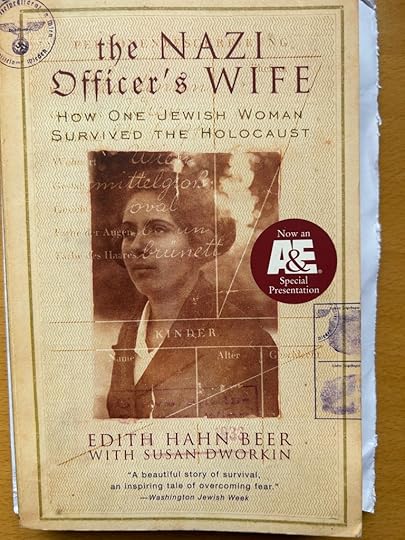
Written by Edith Hahn Beer, this is the incredible story of a young Jewish woman who managed to survive as a ‘U-boat’ or submarine, i.e., someone ‘hidden in full view,’ during the Holocaust. The ability to assume the identity of a non-Jew and thus to live as a member of the wider society of Gentiles (Aryans) at a time when Nazi ideology condemned all Jews to death depended on gaining the help, support and cooperation of a number of people, both Jews and non-Jews, as well as on the individual’s ability to transcend the ever-present fear of detection and present a false face to the world.
Edith Kahn grew up in pre-war Vienna and was accustomed to living a comfortable life, enjoying the cultural and social benefits of the Austrian capital. She had overcome her father’s resistance to her registration as a student at the university and was near completion of her law studies when Austria became part of Germany with the Anschluss of 1938. As Nazi control of the city tightened, Edith and her parents were forced to leave their comfortable home and move into a smaller apartment, and eventually to the ghetto where Vienna’s Jews were confined. Edith was forcibly conscripted to a labour camp and sent to work on a farm harvesting asparagus and other vegetables, living under difficult conditions, and separated from her parents, sisters and friends, thtough she managed to correspond with them. After her two sisters had managed to get to England and Palestine respectively, and her father had suddenly died from natural causes her mother was left alone in Vienna, but continued to send Edith occasional packages with food and/or clothes.
When the labour camp was dissolved Edith returned to Vienna, where she was given advice by a friend who was familiar with the way the Nazi bureaucracy worked. As a result, Edith managed to obtain the documents of a Gentile friend and assume her identity, and thus was able to avoid being sent to a concentration camp together with her mother and all the Jews of Vienna. On an impulse, Edith decided to go to the town of Munich, where she managed to start her new life, first as a seamstress and later as an orderly or nursing assistant in a Red Cross hospital just outside the town.
Visiting an art exhibition after work one day she fell into conversation with a handsome stranger, who eventually declared his love for her and proposed marriage. She accepted reluctantly and revealed her true identity to him. He persisted with his desire to marry her, and she consented in the knowledge that she would have to be obedient and submissive, performing the role of the traditional German housewife. She managed to do this throughout the period of the war, and even to get pregnant and have a child by her husband, who worked painting planes in an aeronautics factory but was eventually conscripted into the German army as the Nazi war machine conscripted ever-more unsuitable men and boys. Eventually Edith’s husband was captured by the Russians and sent to Siberia, where he remained until the end of the war.
After the war, under Russian occupation, Edith revealed her true identity and was appointed a judge in the Munich legal system. She managed to get her husband released from Siberia, but their relations were not as they had formerly been, and they eventually divorced. By a supreme effort, Edith managed to leave Germany and emigrate with her daughter first to England and then to Israel, where she finally could feel at home.
December 31, 2023
A New Home for the Bezalel Academy
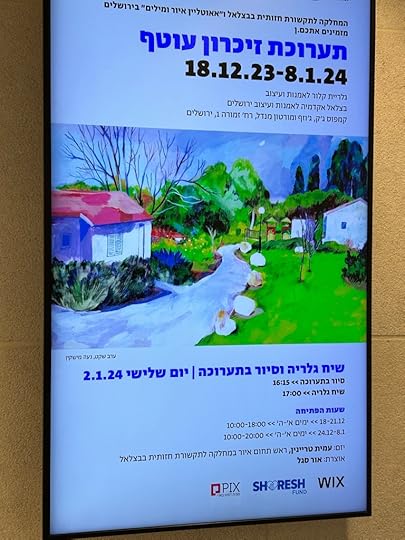
The Bezalel Academy of Arts and Design, Israel’s foremost art academy, is named for Bezalel ben Uri, who is mentioned in the Bible as the artist and artisan responsible for designing and building the Tabernacle and the Ark of the Law when the Children of Israel were making their long journey to the Promised Land. The concept of a Zionist academy producing artists and artisans engaged in creating artistic artifacts in a variety of media was first proposed in 1903 by the artist Boris Schatz, and gained the immediate support of the Zionist Congress. This led to the establishment of the academy in Jerusalem in 1906, long before Israel existed as an independent state. Since then it has grown and developed, undergoing a series of transformations and modifications, moving from one site to another in Jerusalem until its latest incarnation in its grand new custom-built building in downtown Jerusalem. So, from its symbolic ‘ivory tower’ on Mount Scopus, the Academy has moved to become embedded in the very heart of the capital, close to the Old City of Jerusalem.
The new location is adjacent to the building of the Jerusalem Municipality on the site known as the Russian Compound, where the Russian church, the Magistrate’s Court and the offices (and holding cells) of the Israel Police Force are located. The exterior of the huge new Bezalel Academy building consists of an expanse of glass windows, evidently aspiring to provide those within with maximum natural daylight. Inside the building the various departments fill the four spacious storeys with plenty of room for workshops, classrooms, studios and exhibition space. The departments include several, such as the Department of Visual Communication, the Media and Technology Center and the Department of Screen-Based Arts, which cannot have been imagined at the time the Academy was founded. An expansive, well-equipped dining room or mensa, along which runs an open terrace, provides an entrancing (and appetizing) view over Jerusalem. No one is ever going to feel claustrophobic in this building.
A plaque embedded into the entrance wall of the building states in Hebrew, Arabic and English: “Bezalel Academy of Arts and Design, Jerusalem; Based on principles of human dignity, equality, pluralism and freedom of thought, speech and creative expression.” One can only hope that the students, who come from all segments of Israeli society, will benefit from this noble aspiration.
When I visited the building it was hosting an exhibition entitled ‘Remembering the Gaza Border Region,’ presenting graphic depictions of the western Negev area on the border with Gaza which was attacked by Hamas terrorists on October 7, 2023. The works depict life in the region before the massacre, focusing on its serenity and agricultural character. It also seeks to raise funds to assist the residents of the area who have had to leave their devastated homes.
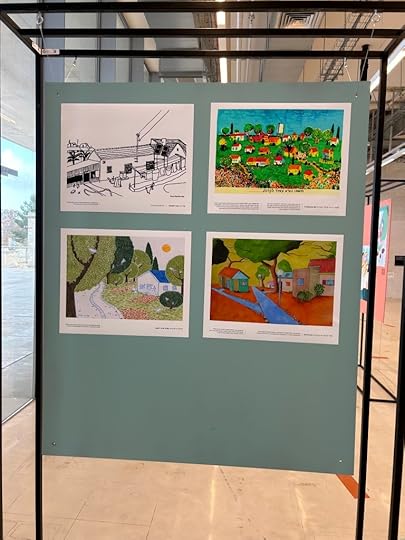
The new location of the Bezalel Academy of Arts and Design in the centre of Jerusalem brings its students into contact with the city’s general population, which is drawn from a wide variety of cultures, ethnic groups, occupations and backgrounds. It also gives the residents of Jerusalem the opportunity to absorb aspects of art and culture which were previously far removed from their everyday life. Hopefully, both sides will benefit from this interaction.

